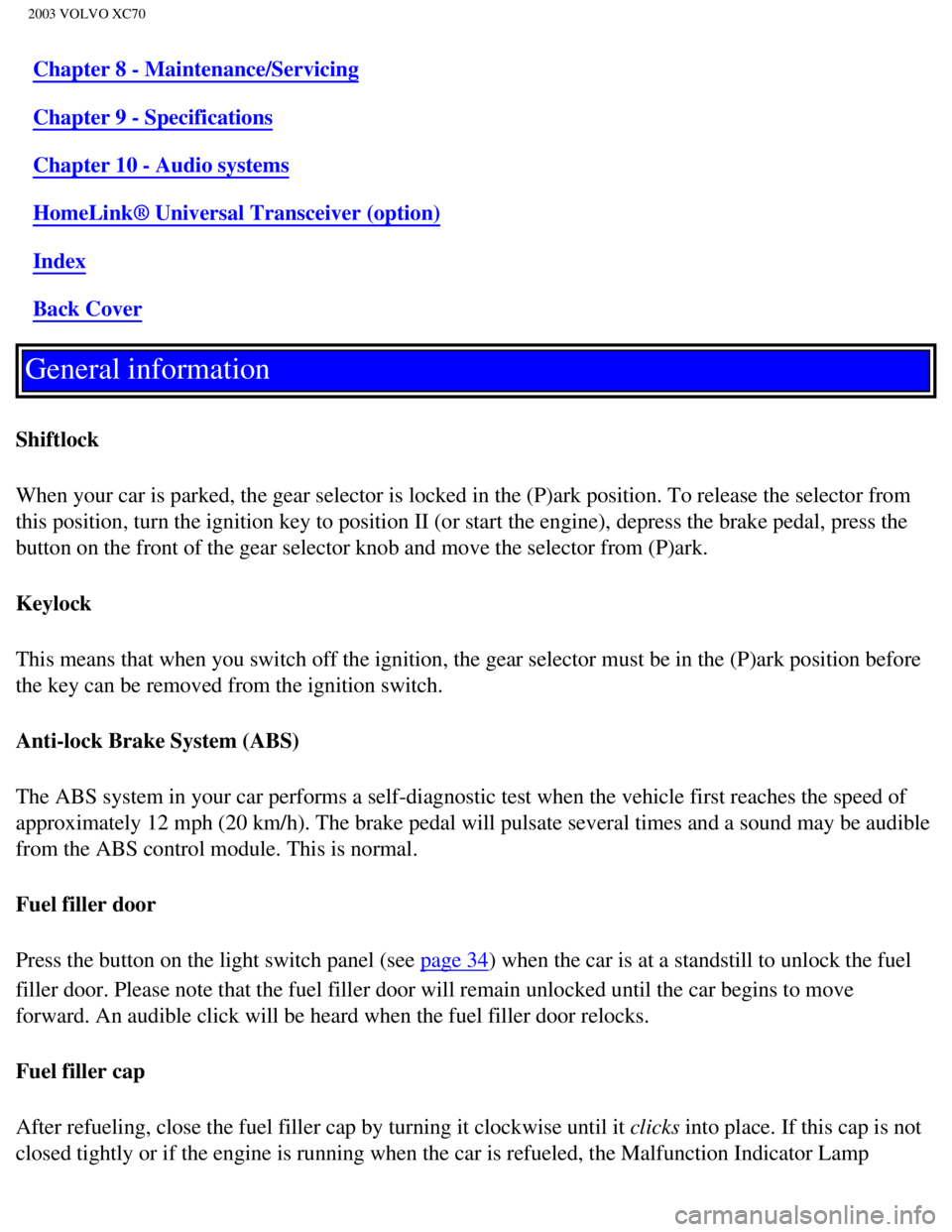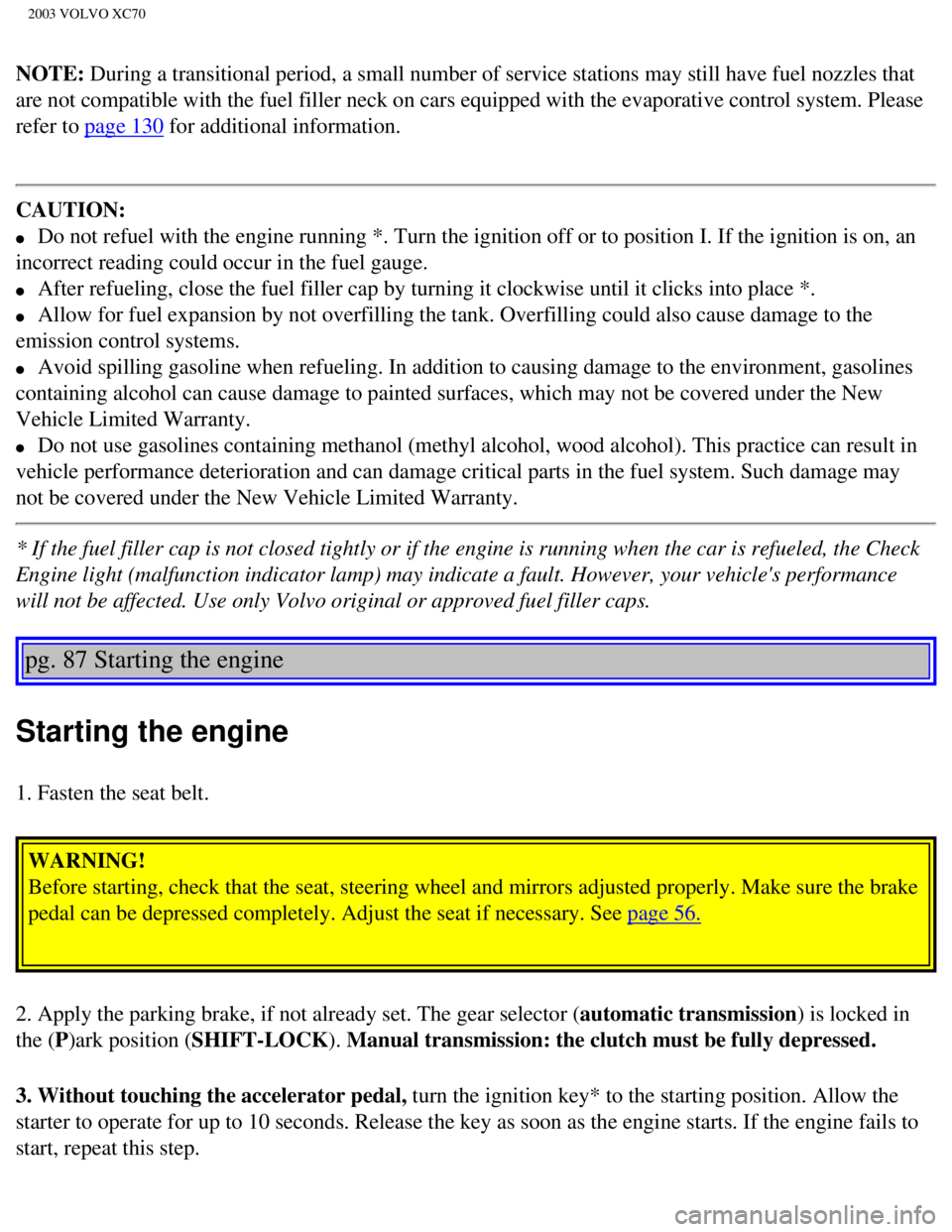fuel cap release VOLVO XC70 2003 Owners Manual
[x] Cancel search | Manufacturer: VOLVO, Model Year: 2003, Model line: XC70, Model: VOLVO XC70 2003Pages: 257, PDF Size: 5.33 MB
Page 3 of 257

2003 VOLVO XC70
Chapter 8 - Maintenance/Servicing
Chapter 9 - Specifications
Chapter 10 - Audio systems
HomeLink® Universal Transceiver (option)
Index
Back Cover
General information
Shiftlock
When your car is parked, the gear selector is locked in the (P)ark pos\
ition. To release the selector from
this position, turn the ignition key to position II (or start the engin\
e), depress the brake pedal, press the
button on the front of the gear selector knob and move the selector from\
(P)ark.
Keylock
This means that when you switch off the ignition, the gear selector must\
be in the (P)ark position before
the key can be removed from the ignition switch.
Anti-lock Brake System (ABS)
The ABS system in your car performs a self-diagnostic test when the vehi\
cle first reaches the speed of
approximately 12 mph (20 km/h). The brake pedal will pulsate several t\
imes and a sound may be audible
from the ABS control module. This is normal.
Fuel filler door
Press the button on the light switch panel (see
page 34) when the car is at a standstill to unlock the fuel
filler door. Please note that the fuel filler door will remain unlocked \
until the car begins to move
forward. An audible click will be heard when the fuel filler door relock\
s.
Fuel filler cap
After refueling, close the fuel filler cap by turning it clockwise until\
it clicks into place. If this cap is not
closed tightly or if the engine is running when the car is refueled, the\
Malfunction Indicator Lamp
file:///K|/ownersdocs/2003/2003_XC70/03xc70_00.htm (3 of 6)12/30/2006 \
4:17:50 PM
Page 128 of 257

2003 VOLVO XC70
NOTE: During a transitional period, a small number of service stations may sti\
ll have fuel nozzles that
are not compatible with the fuel filler neck on cars equipped with the e\
vaporative control system. Please
refer to
page 130 for additional information.
CAUTION:
l Do not refuel with the engine running *. Turn the ignition off or to pos\
ition I. If the ignition is on, an
incorrect reading could occur in the fuel gauge.
l After refueling, close the fuel filler cap by turning it clockwise until\
it clicks into place *.
l Allow for fuel expansion by not overfilling the tank. Overfilling could \
also cause damage to the
emission control systems.
l Avoid spilling gasoline when refueling. In addition to causing damage to\
the environment, gasolines
containing alcohol can cause damage to painted surfaces, which may not b\
e covered under the New
Vehicle Limited Warranty.
l Do not use gasolines containing methanol (methyl alcohol, wood alcohol)\
. This practice can result in
vehicle performance deterioration and can damage critical parts in the f\
uel system. Such damage may
not be covered under the New Vehicle Limited Warranty.
* If the fuel filler cap is not closed tightly or if the engine is runni\
ng when the car is refueled, the Check
Engine light (malfunction indicator lamp) may indicate a fault. Howeve\
r, your vehicle's performance
will not be affected. Use only Volvo original or approved fuel filler ca\
ps.
pg. 87 Starting the engine
Starting the engine
1. Fasten the seat belt.
WARNING!
Before starting, check that the seat, steering wheel and mirrors adjuste\
d properly. Make sure the brake
pedal can be depressed completely. Adjust the seat if necessary. See
page 56.
2. Apply the parking brake, if not already set. The gear selector (automatic transmission) is locked in
the (P)ark position (SHIFT-LOCK). Manual transmission: the clutch must be fully depressed.
3. Without touching the accelerator pedal, turn the ignition key* to the starting position. Allow the
starter to operate for up to 10 seconds. Release the key as soon as the \
engine starts. If the engine fails to
start, repeat this step.
file:///K|/ownersdocs/2003/2003_XC70/03xc70_06a.htm (5 of 22)12/30/200\
6 4:17:59 PM
Page 187 of 257

2003 VOLVO XC70
pg. 130 Fuel/emissions systems
Fuel system
The fuel system continually compensates for variation in engine load, sp\
eed and temperature. A mass air
flow sensor continuously measures the inducted air and makes rapid adjus\
tments for changes in air
temperature and density, to balance fuel economy, emissions, and engine \
power requirements.
Heated oxygen sensor
This is an emission control system designed to reduce emissions and impr\
ove fuel economy. The heated
oxygen sensor monitors the composition of the exhaust gases leaving the \
engine. The exhaust gas
analysis is fed into an electronic module. This adjusts the air/fuel rat\
io to improve combustion and
reduce the three major pollutants (hydrocarbons, carbon monoxide, and o\
xides of nitrogen (NOx)) via a
three-way catalytic converter.
Crankcase ventilation
The engine is provided with positive crankcase ventilation which prevent\
s crankcase gases from being
released into the atmosphere. Instead, the crankcase gases are routed to\
the intake manifold and
cylinders.
PremAir®
On the surface of the radiator in the engine compartment, there is a spe\
cial coating called PremAir®.
PremAir® works as a catalytic converter, converting most of the ozone\
passing through the radiator into
oxygen, thereby reducing harmful ground-level ozone.
Evaporative control system
The car is equipped with an evaporative control system, which prevents g\
asoline vapor from being
released into the atmosphere.
The system consists of a fuel tank with filler pipe and cap, two rollove\
r valves, a Fill Limit Vent Valve
(FLVV), vapor vent lines, a charcoal canister, a purge line, and a pur\
ge control valve and engine
connections. In addition, there is a pressure sensor connected to the fu\
el tank and a filter-protected
Canister Close Valve (CCV) on the atmospheric side of the canister, fo\
r system diagnosis.
The gasoline vapor is channeled through the rollover valves and the FLVV\
via the vapor vent lines into
the charcoal canister, where it is stored. When the engine is started, t\
he gasoline vapor is drawn from the
file:///K|/ownersdocs/2003/2003_XC70/03xc70_08b.htm (1 of 16)12/30/200\
6 4:18:04 PM